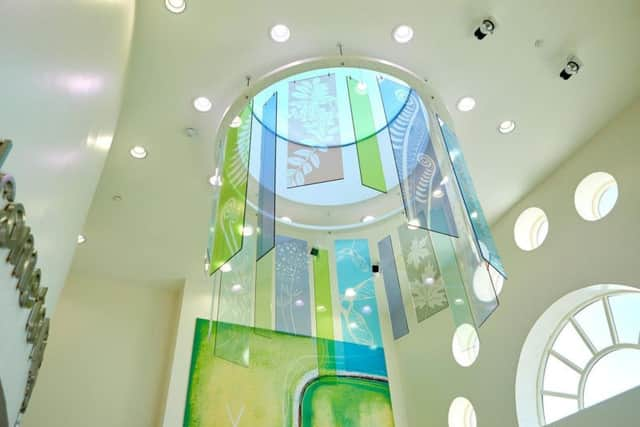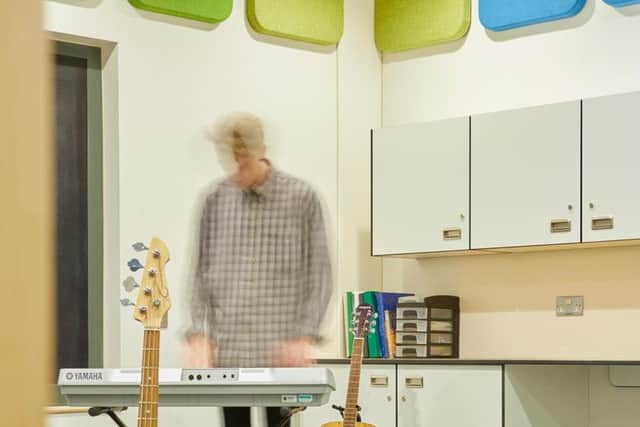How St Andrew's want to make Northampton the mental health care capital of the world


It can support up to 110 young people with complex conditions, who not only live there but are schooled on site and can access sports facilities, sensory therapy rooms, animal care courtyards and the chance to learn music and art.
The patients were involved in its development at every stage and helped to name its wards and design its decorating. Their college was recently rated 'outstanding' by Ofsted and has a unique science lab where teachers are instructed by students out of harm's way from hazardous chemicals. It's a one-of-a-kind approach to mental health care for young people and what CEO Gil Baldwin has called 'a major milestone.'
Advertisement
Hide AdAdvertisement
Hide Ad"Each patient has a bespoke treatment plan which is led by them, at their pace," he said. "They have access to our outstanding college, music therapy and a flagship sensory integration approach which helps them to build their resilience for the future and increase their independence."


The Chronicle & Echo was invited to St Andrew's to see the new facility.
We were not allowed inside. And quite rightly, too.
"It's a wonderful facility, but it just is not open to the public," says Liz Falconer, head of communications at St Andrew's Northampton, and our tour guide. "The patients of FitzRoy could be facing a very difficult time of their lives. It's best that only patient families should visit."
This is St Andrew's catch-22. They are keen to explain to the Northampton community the work they do, but the nature of mental health care means much of what happens on site is confidential. They want to blow away the cobwebs around mental health and help their neighbours understand their work, but also must keep many doors closed.
Advertisement
Hide AdAdvertisement
Hide Ad

"It can lead to misgivings because we seem secretive," says Liz. "We want to change that. Mental health care has advanced so much in recent years and our understanding of different conditions has grown. There's so much great work going on here but it's not like a tonsillectomy, with a clear cut treatment. There is no single care plan for mental health and every patient must be helped in a different way.
"Victorian-era asylums are gone. We don't want a sense of secrecy around our work, but instead for people to know that we work with the utmost confidentiality, out of respect for our patients."
So what is St Andrew's Healthcare? They are a secure care facility with over 150 acres of ground in south-east Northampton and employ around 3,000 people on site and in the town. Their patients have complex conditions and are referred to them through the NHS and the criminal justice system. They offer treatment to five different specialisations, or 'pathways': men, women, children and adolescents, learning disabilities & autism spectrum, and neuropsychiatry. And they are not private, but a 'trading charity,' who earn their money as a service provider to the NHS and then reinvest back into their own development.
"We want to become a world-class mental health care provider. In the same way you can say 'Great Ormond' and think of child health care, we want to be 'St. Andrew's,' the name you think of for mental health care.
Advertisement
Hide AdAdvertisement
Hide Ad

"We asked ourselves, 'do we have the space to provide world-class health care to children and young people?' The answer was no. So we built FitzRoy."
Space isn't the only problem prompting new building work. An old-fashioned style of thinking still hangs over mental health, and St Andrew's is working hard to escape it. A good illustration of this is in one of their retired wards. It's a corridor that runs nearly the width of the building. The doors here are not flush with the corridor. They are instead inlaid into trench-like alcoves every 10 metres.
"This is the outdated approach to mental health the world has moved on from," says Liz, stepping into an alcove. "This corridor was designed with line-of-sight in mind, to help see patients. But then these alcoves hide you completely."
It works too. Stand in the alcove and you are hidden from anyone in the corridor. It's possible this was how to keep staff safe from distressed patients during an incident in less understanding days. Except patients could hide there, too. And a ward designed with hideaways, tight corridors and obscuring 90-degree angles is now considered a poor approach to treating mental health.
Advertisement
Hide AdAdvertisement
Hide Ad

"We only use this ward for training nurses now," says Liz. "It's just not fit for purpose. FitzRoy and the other newer facilities such as William Wake House are much more open plan and spacious, which is a better environment.”
"This ward is functional. But not ideal. That's why we're not using it for patients anymore. We believe we can do better."
This is the huge logistics challenge facing St Andrew's. As attitudes to mental health change, patients will need to move to new buildings that meet their needs better. But St Andrew's are then tasked with funding a new facility, building it, moving their patients into it and then finding a use for the old buildings. They can't knock them down, as some of the buildings are listed, too. They can only think of a new way to use it to serve their patients and their families.
But progress is being made. In 2011, they opened the William Wake building for adult patients. FitzRoy itself cost £45 million which the charity had to fund themselves. They are coming up with inventive uses for old buildings too. An example is Workbridge, St Andrew's arts and crafts workshop with a cafe and restaurant, which is actually a repurposed laundry house.
Advertisement
Hide AdAdvertisement
Hide Ad"Workbridge has become one of our key buildings," says Liz. "We can help introduce our patients back into the working world. Some of the staff in the cafe are patients and former patients. It's also the best place for the public to visit and help St Andrew's by volunteering, visiting the garden centre and the charity shop. This is how our old buildings can still benefit what we do here."
So the work goes on. FitzRoy has its official opening later this year and then St Andrew's will consider their next development. For now, they are inviting the public to volunteer and grow their understanding of how they work. People can even enrol in the 'befriending' scheme, where they are matched up with a patient to help them make friends.


"It is part of our on-going mission to provide world-class care for all our patients and help them on their road to recovery," says CEO Gil Baldwin.
"St Andrew’s Healthcare is just one link in the chain, but as our young patients follow their recovery pathway back into the community we know we have given them the best tools to deal with the stones life throws and be the person they want to be."